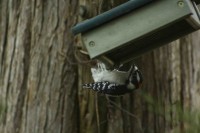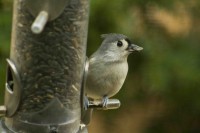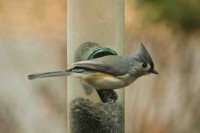As we mentioned in a previous blog entry, this is our 15th winter particpating in Project FeederWatch here at Shaver’s Creek. Here are a few of the common birds that we’ve seen, and that you might see at your feeder this winter:
Purple Finches often forage on seeds, fruits and insects and are a common sight at feeders. They are stockier than their cousin the House Finch, and have a deeply notched, short tail. Their bill is triangular, short and heavy and their wings are short and pointy. Males have a red-pink color on their head and breast, mixing into a brown back. A female or immature has a brown head with white stripes. Finches often come to feeders and munch on black oil sunflower seed. In the winter they can be found around shrub lands, old fields, forest edges and backyards. (Female/immature pictured below)
Black-capped Chickadees are very small with a short neck and a black cap and bib. Their cheeks are white with a grey and white body. These birds do not remain at feeders longer then it takes to grab a seed and go. They often reside in flocks and are found in wooded areas with trees and shrubs or neighborhoods and parks.
Downy Woodpeckers are the smallest of our local woodpecker clan. They are acrobatic feeders perfectly at home hanging upside down on a suet feeder. They may be easily confused with a Hairy Woodpecker but have a smaller bill and black barring on the white outer tail feathers. In addition, males have a small red patch on the back of their head. They can be found in open woodlands often among deciduous trees and shrubs. (Male pictured below)
A Tufted Titmouse is large compared to other songbirds and is easily recognized by their pointed crest and stout bill. They have grayish-blue upper parts, orange flanks and a white underbelly. Titmice are found in eastern woodlands below 2,000 ft in deciduous or evergreen forests.
The largest of the Nuthatches is the White-breasted Nuthatch with a small head and almost no neck. They have a long, slightly upturned bill and short tail. Their body is grayish-blue with white cheeks and underbelly. White-breasted Nuthatches creep along branches and tree trunks, probing into burrows to find food. They often forage side-ways or upside down. They can be found in deciduous, mixed deciduous and coniferous forests, often nesting in open areas.
Red-breasted Nuthatches are small but quick birds who also forage upside down and sideways along tree trunks and branches. They have a plump, small body with almost no neck. They are identified by a black cap that is interrupted with a white stripe over the eye. Their under parts are a rusty-red. During winter months, Red-breasted Nuthatches are a common sight at feeders eating peanuts, sunflower seeds and suet. These resilient birds mainly occupy deciduous woods and mountains.
You can learn more about these and other birds at Cornell’s “All About Birds” website: http://www.allaboutbirds.org/
– Chrysalis & Canopy, Fall 2010 Interns
All images Copyright 2010 Kaitlin Pope






